agar berry jam
 The Big Book of Preserving the Harvest is loaded with recipes for canning, freezing, drying, pickling and other means of preserving fresh produce. You might think this is part of the recent resurgence of home preserving that’s come in the wake of the locavore and real food movement, but I’ve owned this book for several years and have used it a number of times.
The Big Book of Preserving the Harvest is loaded with recipes for canning, freezing, drying, pickling and other means of preserving fresh produce. You might think this is part of the recent resurgence of home preserving that’s come in the wake of the locavore and real food movement, but I’ve owned this book for several years and have used it a number of times.
This meant that in keeping with the project rules, I had to choose something I haven’t already made. In principle I embrace this constraint, but as I flipped through the book I gnashed my teeth in frustration at the delights I would have to skip over this time: lemon jelly, spiced peach jam, blueberry and cherry preserves, ginger jam. It occurred to me that most of t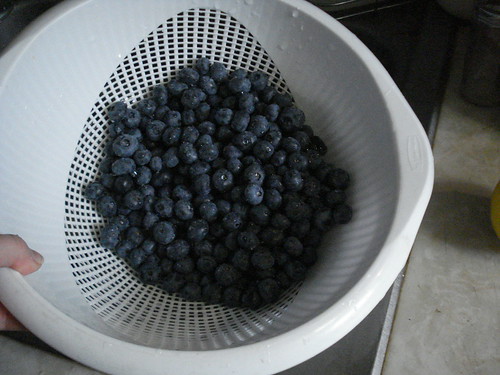 he pickling chapter was open to me; when making pickles in the past I’ve followed a recipe provided by a friend, sometimes with improvisation (green beans or asparagus instead of cucumbers, additional garlic), and only used this book for general guidance. However, pickling cucumbers still seem to be pretty new in the Greenmarket and were looking rather anemic on Monday, Brussels sprouts aren’t expected until August at soonest, and the cauliflower recipe calls for 10 pounds — more than I felt up to hauling home on the subway, let alone finding consumers for in the next few months. I don’t have a food dryer, and lack enthusiasm for flavored vinegars, so freezing or canning seemed to be my best bets; my pressure cooker seems to have lost its gauge during the move and is now just an extremely large pot with a tight-fitting lid, so hot-water-bath canning is my only heat-processing option.
he pickling chapter was open to me; when making pickles in the past I’ve followed a recipe provided by a friend, sometimes with improvisation (green beans or asparagus instead of cucumbers, additional garlic), and only used this book for general guidance. However, pickling cucumbers still seem to be pretty new in the Greenmarket and were looking rather anemic on Monday, Brussels sprouts aren’t expected until August at soonest, and the cauliflower recipe calls for 10 pounds — more than I felt up to hauling home on the subway, let alone finding consumers for in the next few months. I don’t have a food dryer, and lack enthusiasm for flavored vinegars, so freezing or canning seemed to be my best bets; my pressure cooker seems to have lost its gauge during the move and is now just an extremely large pot with a tight-fitting lid, so hot-water-bath canning is my only heat-processing option.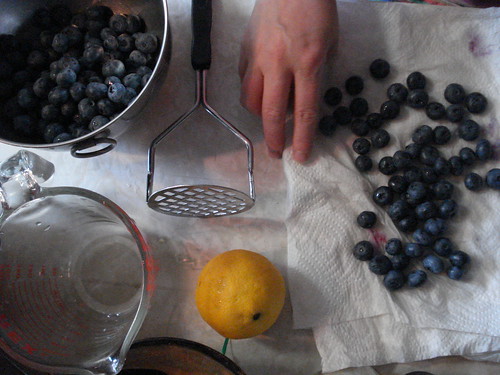
This still left a lot of choices in the jams and jellies section; I made a shopping list organized by recipe, to prevent picking up all but one necessary ingredient for anything, and set out to Union Square. Blackberry preserves? No blackberries to be seen. Red raspberry preserves? Maybe, but raspberries seem expensive even by New York standards. (Four years after moving, I am still facing up to the fact that the New York area is just not the berry wonderland that Western Oregon is.) Blueberry marmalade? Excellent! I loaded up on blueberries, and picked up small quantities of some other fruits for freezing and nibbling, and it wasn’t until I got home that I realized that the blueberry marmalade recipe called for liquid pectin. Which perhaps I could have found if I had 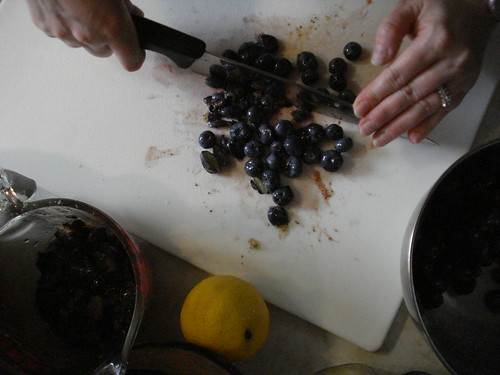 worked the phones and ventured out to Brooklyn, or found an online vendor a week ago, but I did not plan ahead that well. I could have made my own with several pounds of apples plus a lot of patience and effort; I tend to be good at effort, and I could probably have found organic apples in my neighborhood, but my patience was getting scarce. Frustrated, I decided to table the issue for an hour or so and go get iced coffee, and on my way I spotted the neighborhood’s natural food store, which did not have liquid pectin but did have agar, an ingredient in agar berry jam, for which my blueberries would do nicely. Canning day was saved.
worked the phones and ventured out to Brooklyn, or found an online vendor a week ago, but I did not plan ahead that well. I could have made my own with several pounds of apples plus a lot of patience and effort; I tend to be good at effort, and I could probably have found organic apples in my neighborhood, but my patience was getting scarce. Frustrated, I decided to table the issue for an hour or so and go get iced coffee, and on my way I spotted the neighborhood’s natural food store, which did not have liquid pectin but did have agar, an ingredient in agar berry jam, for which my blueberries would do nicely. Canning day was saved.
Agar is a vegetable gelatin made from seaweed. Or as the package puts it, “a variety of sea vegetables,” which sounds 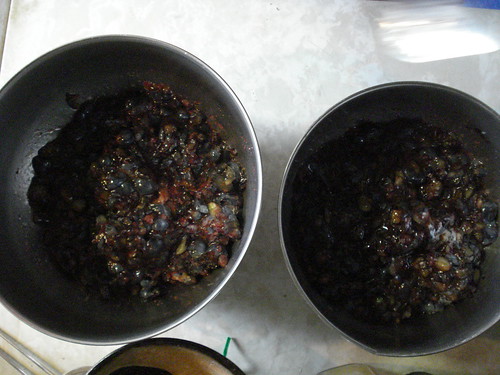 like a sort of aquatic succotash. (They can’t just be using that phrasing to avoid saying “seaweed,” because the word “seaweed” appears in the next sentence.) It comes in flakes, which you dissolve in hot water and then cool to set. It’s a good thickener for puddings and baked goods, especially for vegetarians (since gelatin is an animal product), and I’ve had it before in desserts at my favorite vegetarian dim sum restaurant. I had never cooked with agar before, but I thought it sounded a lot easier than trying to make my own liquid pectin from fresh apples.
like a sort of aquatic succotash. (They can’t just be using that phrasing to avoid saying “seaweed,” because the word “seaweed” appears in the next sentence.) It comes in flakes, which you dissolve in hot water and then cool to set. It’s a good thickener for puddings and baked goods, especially for vegetarians (since gelatin is an animal product), and I’ve had it before in desserts at my favorite vegetarian dim sum restaurant. I had never cooked with agar before, but I thought it sounded a lot easier than trying to make my own liquid pectin from fresh apples.
Before you start to work with the fruit, you will want to prepare your jars. Agar berry jam is not pressure-sealed in a hot-water bath, but it is still 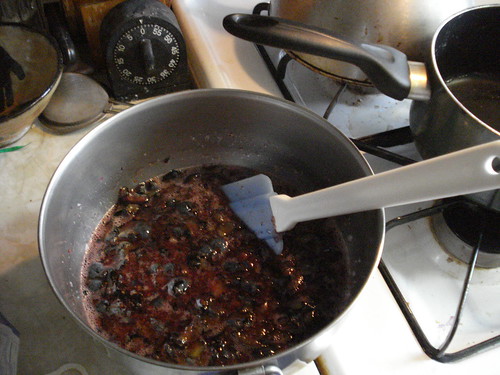 packed into jam jars, four half-pints per recipe. Wash the jars well and then sterilize them in boiling water; also wash the canning lids and rings, and warm them in hot (not boiling) water. It’s also helpful to have a jar lifter, to help you remove the jars from the sterilizing bath, and a canning funnel, for filling the jars without mess.
packed into jam jars, four half-pints per recipe. Wash the jars well and then sterilize them in boiling water; also wash the canning lids and rings, and warm them in hot (not boiling) water. It’s also helpful to have a jar lifter, to help you remove the jars from the sterilizing bath, and a canning funnel, for filling the jars without mess.
To make agar berry jam you chop up a couple of quarts of the berries of your choice, with an end goal of three cups of fruit. I wasn’t sure if blueberries would take to chopping with a knife — I had visions of berries ricocheting through the kitchen in a sort of sugary slapstick — but a few minutes with a potato masher convinced me that the knife was worth trying, and  chopping with it turned out to be surprisingly easy. To the three cups of fruit you add a tablespoon of lemon juice. Then you pour a cup of water into a small saucepan, add two tablespoons of agar flakes, and bring the water to a simmer without stirring. Once it’s simmering, stir the liquid until the flakes dissolve, which takes about five minutes. Of constant stirring. Seriously. Once all the flakes have dissolved, give thanks, then pour in a quarter-cup of honey and stir thoroughly; then pour the agar mixture into the berries (not vice versa; you do not actually cook the berries) and mix it all well.
chopping with it turned out to be surprisingly easy. To the three cups of fruit you add a tablespoon of lemon juice. Then you pour a cup of water into a small saucepan, add two tablespoons of agar flakes, and bring the water to a simmer without stirring. Once it’s simmering, stir the liquid until the flakes dissolve, which takes about five minutes. Of constant stirring. Seriously. Once all the flakes have dissolved, give thanks, then pour in a quarter-cup of honey and stir thoroughly; then pour the agar mixture into the berries (not vice versa; you do not actually cook the berries) and mix it all well.
Now your jam is ready to can. Pour it into your jars, leaving about half an inch of headspace (I was pleased to see the jam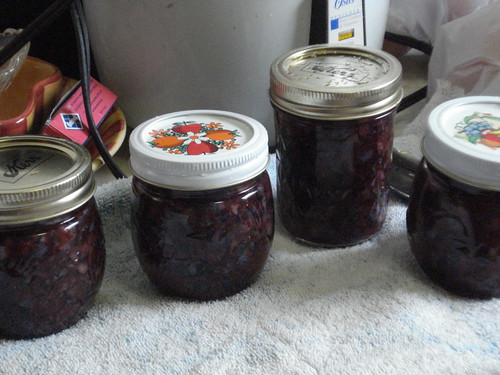 fit nicely into the number of jars specified, with no half-filled jars or leftovers), then add the lids and secure them with the rings. Put the jars into the refrigerator to cool for at least 12 hours; after that you can label and freeze the jars. Or just start eating from them.
fit nicely into the number of jars specified, with no half-filled jars or leftovers), then add the lids and secure them with the rings. Put the jars into the refrigerator to cool for at least 12 hours; after that you can label and freeze the jars. Or just start eating from them.
A few hours after I’d put the jars to chill, I opened one and found that the jam had set nicely. Because agar is clear, the color of the berries comes through beautifully. And rest assured, the taste was lovely: very fresh and fruity, with just the right amount of sweetness from the honey.
Verdict: Success. The recipe was easy to follow, and the descriptions used give you good guidance to make sure you’re doing things right as you work. The jam was delicious. 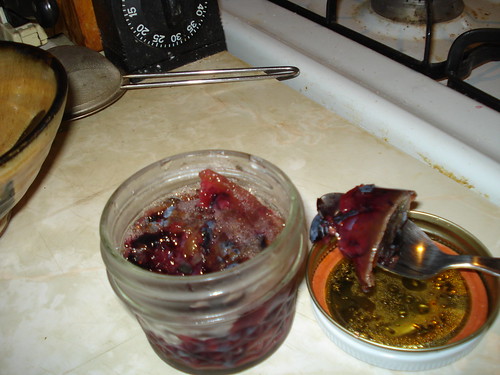 Because it’s not pressure-sealed I won’t be able to mail it as gifts, but I should be able to give frozen jars to local friends and have it keep well until they can get it home. Assuming we don’t just eat it all ourselves. As for pickling, I’ll be tackling that during a vacation week in August, but it won’t count toward the project.
Because it’s not pressure-sealed I won’t be able to mail it as gifts, but I should be able to give frozen jars to local friends and have it keep well until they can get it home. Assuming we don’t just eat it all ourselves. As for pickling, I’ll be tackling that during a vacation week in August, but it won’t count toward the project.
Man, I can’t wait to eat this tomorrow.
[…] — an anniversary celebration. (Quite the 107 Cookbooks festivity, this meal, featuring the blueberry jam and the minty fresh smoothie as […]